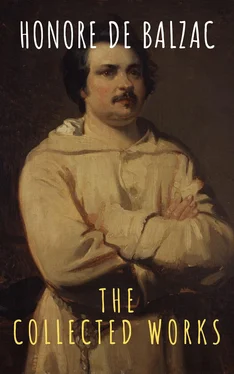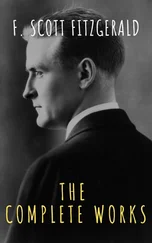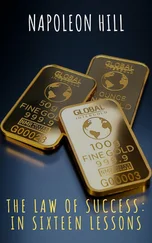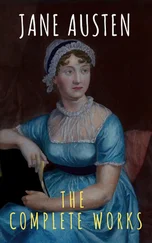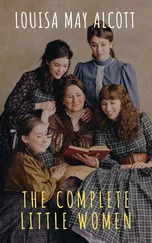One of the lines which the Touchards, father and son, endeavored to monopolize, and the one most stoutly disputed (as indeed it still is), is that of Paris to Beaumont-sur-Oise, — a line extremely profitable, for three rival enterprises worked it in 1822. In vain the Touchards lowered their price; in vain they constructed better coaches and started oftener. Competition still continued, so productive is a line on which are little towns like Saint-Denis and Saint-Brice, and villages like Pierrefitte, Groslay, Ecouen, Poncelles, Moisselles, Monsoult, Maffliers, Franconville, Presles, Nointel, Nerville, etc. The Touchard coaches finally extended their route to Chambly; but competition followed. To-day the Toulouse, a rival enterprise, goes as far as Beauvais.
Along this route, which is that toward England, there lies a road which turns off at a place well-named, in view of its topography, The Cave, and leads through a most delightful valley in the basin of the Oise to the little town of Isle-Adam, doubly celebrated as the cradle of the family, now extinct, of Isle-Adam, and also as the former residence of the Bourbon-Contis. Isle-Adam is a little town flanked by two large villages, Nogent and Parmain, both remarkable for splendid quarries, which have furnished material for many of the finest buildings in modern Paris and in foreign lands, — for the base and capital of the columns of the Brussels theatre are of Nogent stone. Though remarkable for its beautiful sites, for the famous chateaux which princes, monks, and designers have built, such as Cassan, Stors, Le Val, Nointel, Persan, etc., this region had escaped competition in 1822, and was reached by two coaches only, working more or less in harmony.
This exception to the rule of rivalry was founded on reasons that are easy to understand. From the Cave, the point on the route to England where a paved road (due to the luxury of the Princes of Conti) turned off to Isle-Adam, the distance is six miles. No speculating enterprise would make such a detour, for Isle-Adam was the terminus of the road, which did not go beyond it. Of late years, another road has been made between the valley of Montmorency and the valley of the Oise; but in 1822 the only road which led to Isle-Adam was the paved highway of the Princes of Conti. Pierrotin and his colleague reigned, therefore, from Paris to Isle-Adam, beloved by every one along the way. Pierrotin’s vehicle, together with that of his comrade, and Pierrotin himself, were so well known that even the inhabitants on the main road as far as the Cave were in the habit of using them; for there was always better chance of a seat to be had than in the Beaumont coaches, which were almost always full. Pierrotin and his competitor were on the best of terms. When the former started from Isle-Adam, the latter was returning from Paris, and vice versa.
It is unnecessary to speak of the rival. Pierrotin possessed the sympathies of his region; besides, he is the only one of the two who appears in this veracious narrative. Let it suffice you to know that the two coach proprietors lived under a good understanding, rivalled each other loyally, and obtained customers by honorable proceedings. In Paris they used, for economy’s sake, the same yard, hotel, and stable, the same coach-house, office, and clerk. This detail is alone sufficient to show that Pierrotin and his competitor were, as the popular saying is, “good dough.” The hotel at which they put up in Paris, at the corner of the rue d’Enghien, is still there, and is called the “Lion d’Argent.” The proprietor of the establishment, which from time immemorial had lodged coachmen and coaches, drove himself for the great company of Daumartin, which was so firmly established that its neighbors, the Touchards, whose place of business was directly opposite, never dreamed of starting a rival coach on the Daumartin line.
Though the departures for Isle-Adam professed to take place at a fixed hour, Pierrotin and his co-rival practised an indulgence in that respect which won for them the grateful affection of the country-people, and also violent remonstrances on the part of strangers accustomed to the regularity of the great lines of public conveyances. But the two conductors of these vehicles, which were half diligence, half coucou, were invariably defended by their regular customers. The afternoon departure at four o’clock usually lagged on till half-past, while that of the morning, fixed for eight o’clock, was seldom known to take place before nine. In this respect, however, the system was elastic. In summer, that golden period for the coaching business, the rule of departure, rigorous toward strangers, was often relaxed for country customers. This method not infrequently enabled Pierrotin to pocket two fares for one place, if a countryman came early and wanted a seat already booked and paid for by some “bird of passage” who was, unluckily for himself, a little late. Such elasticity will certainly not commend itself to purists in morality; but Pierrotin and his colleague justified it on the varied grounds of “hard times,” of their losses during the winter months, of the necessity of soon getting better coaches, and of the duty of keeping exactly to the rules written on the tariff, copies of which were, however, never shown, unless some chance traveller was obstinate enough to demand it.
Pierrotin, a man about forty years of age, was already the father of a family. Released from the cavalry on the great disbandment of 1815, the worthy fellow had succeeded his father, who for many years had driven a coucou of capricious flight between Paris and Isle-Adam. Having married the daughter of a small inn-keeper, he enlarged his business, made it a regular service, and became noted for his intelligence and a certain military precision. Active and decided in his ways, Pierrotin (the name seems to have been a sobriquet) contrived to give, by the vivacity of his countenance, an expression of sly shrewdness to his ruddy and weather-stained visage which suggested wit. He was not without that facility of speech which is acquired chiefly through “seeing life” and other countries. His voice, by dint of talking to his horses and shouting “Gare!” was rough; but he managed to tone it down with the bourgeois. His clothing, like that of all coachmen of the second class, consisted of stout boots, heavy with nails, made at Isle-Adam, trousers of bottle-green velveteen, waistcoat of the same, over which he wore, while exercising his functions, a blue blouse, ornamented on the collar, shoulder-straps and cuffs, with many-colored embroidery. A cap with a visor covered his head. His military career had left in Pierrotin’s manners and customs a great respect for all social superiority, and a habit of obedience to persons of the upper classes; and though he never willingly mingled with the lesser bourgeoisie, he always respected women in whatever station of life they belonged. Nevertheless, by dint of “trundling the world,” — one of his own expressions, — he had come to look upon those he conveyed as so many walking parcels, who required less care than the inanimate ones, — the essential object of a coaching business.
Warned by the general movement which, since the Peace, was revolutionizing his calling, Pierrotin would not allow himself to be outdone by the progress of new lights. Since the beginning of the summer season he had talked much of a certain large coach, ordered from Farry, Breilmann, and Company, the best makers of diligences, — a purchase necessitated by an increasing influx of travellers. Pierrotin’s present establishment consisted of two vehicles. One, which served in winter, and the only one he reported to the tax-gatherer, was the coucou which he inherited from his father. The rounded flanks of this vehicle allowed him to put six travellers on two seats, of metallic hardness in spite of the yellow Utrecht velvet with which they were covered. These seats were separated by a wooden bar inserted in the sides of the carriage at the height of the travellers’ shoulders, which could be placed or removed at will. This bar, specially covered with velvet (Pierrotin called it “a back”), was the despair of the passengers, from the great difficulty they found in placing and removing it. If the “back” was difficult and even painful to handle, that was nothing to the suffering caused to the omoplates when the bar was in place. But when it was left to lie loose across the coach, it made both ingress and egress extremely perilous, especially to women.
Читать дальше
